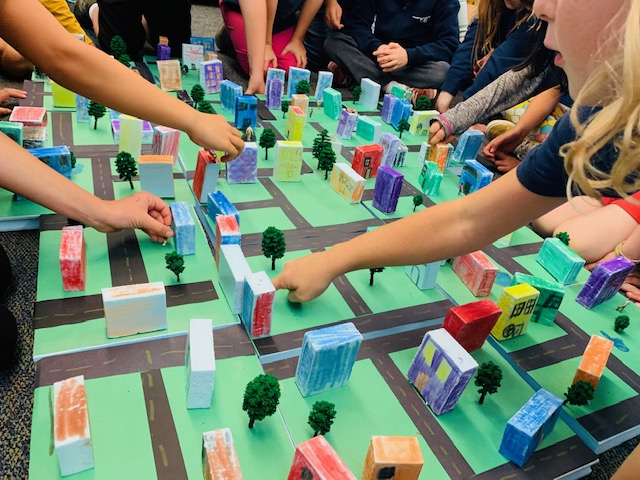
https://www.sdmrm.org/steam-school-programs
Communities Then & Now: Making a 3D Model
Grades TK-2nd
How are we alike and/or different from people who lived in the past? This program features our unique collection of historic California model railroads to engage students in an exploration of the past, and an understanding of how some things change while others stay the same. Students identify community elements on model railroad layouts and compare and contrast them to their contemporary equivalents. Finally, students build a 3D model of their community.
Standards:
NGSS:
K-PS2-1, K-ESS2-2, 1-LS1-1, 2-PS1-2
California History-Social Science:
K.4., K.6., K.6.3.,1.2., 1.2.1., 1.2.2., 1.4, 1.4.2., 2.2
| K-ESS2-2. | Construct an argument supported by evidence for how plants and animals (including humans) can change the environment to meet their needs. [Clarification Statement: Examples of plants and animals changing their environment could include a squirrel digs in the ground to hide its food and tree roots can break concrete.] |
|---|
https://www.cilc.org/ContentProvider/Program.aspx?id=7985
Program Details
Format
1. The program begins with a general discussion about community.
2. Students identify different things located in their community.
3 Students then begin to build their individual 3D community models.
4 Using images, students compare and contrast communities from the past to the present communities.
Objectives
Students will:
– examine a large 3D model of a community.
– learn about and discuss the concept of community.
– describe their communities and identify things located there.
– create an individual 3D community model.
– compare and contrast past communities with contemporary communities.
Standards Alignment
National Standards
CCSS.ELA -Literacy.SL.K.4
CSS.ELA-Litaracy.SL.K.5
CCSS.ELA-Litaracy.SL.K.6
State Standards
California History-Social Science:
K.4., K.6., K.6.3.,1.2., 1.2.1., 1.2.2., 1.4, 1.4.2., 2.2
Resources:
3D Towns – Second Grade STEM
The second grade students studied shapes and 3D figures in STEM and classroom math prior to accepting this challenge. They used their imaginations and engineering skills to construct a town made of many buildings. They included a library, house, fire station, post office, veterinarian, grocery store, etc. Each team was given 3 buildings to build onto a foam board. The students were required to sketch out their buildings to include the shape or 3D figure to be used for each part of the construction. Once they were ready to begin, they stood above the foam board to see the possible locations of the structures. Squares and rectangles were drawn on the board to show the footprint of the building. This is where it is located and from which it will be built upward. Understanding this concept was a bit challenging for them, but they began to understand how this works in the real world. Once the buildings were up, they began to add details. There were stop signs, stop lights, roads, ponds, flowers, bridges, power lines, etc. Finally, we put all of the foam board sections together to form a 3D town we called “Kitty Town”! It looked amazing! It was a lot of work, but they did great and had fun too.
Terrace Town
https://nextcity.org/urbanist-news/in-madison-public-school-students-build-a-city-every-year
The neighborhood Greenwald’s students help build is part of the Terrace Town project, a 13-week urban planning project that culminates with the students building model neighborhoods that are displayed together at Monona Terrace, Madison’s convention center. This year’s project ended recently, with model neighborhoods built by students from across the city and county on display.
As part of the project, students also visit the local sewage treatment plant and a landfill.
“We spent the better part of one session talking about urban design that is child friendly,” says Hirsch. Their answers, he says, reflect their realities, such as wanting to be able to reach a park without crossing a street. “A lot of it had to do with outdoor play areas,” says Hirsch. “A few of them mentioned outdoor sculptures, public art, big stuff, but mostly it was sports and play areas.”
Says Greenwald: “They don’t have a lot of opportunities to design and build something in their regular classroom. I think that’s the part that they love and that’s the part they remember the most.”
Box City
https://cube-education.org/box-city
Box City curriculum is the premier activity used to teach the roles and opportunities each person has in creating their community. Through active listening, cooperation & creativity, participants learn valuable lessons in leadership and design. From the starting point of a city plan, each person can design their school, home, church, government building, community center, airport, & place it in a position that positively impacts the neighborhood. Box City is copyrighted.
BOXES, custom designed to facilitate a Box City curriculum, are offered by an independent company who can be contacted for pricing, shipping information and availability. Other options for developing boxes, city grids, & are outlined in the Box City Guidance.